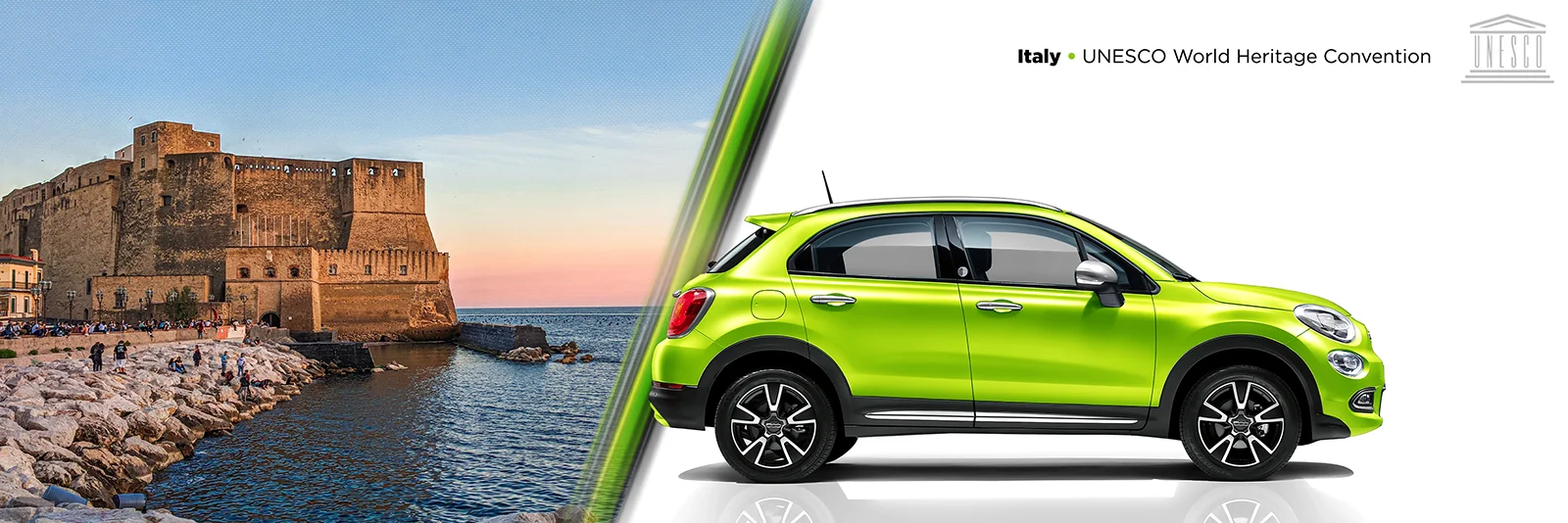IT
EN
ES
FR
IT
EN
ES
FR
With its narrow streets, historical palaces, churches, and squares, Naples' historic center narrates a millennia-old story, blending various architectural styles and cultural influences.
One of the prime attractions is the monumental complex of San Lorenzo Maggiore, a masterpiece from the medieval period. The Cathedral of Santa Maria Assunta, nestled in the heart of the historic center, showcases superb examples of Gothic and Baroque architecture. The churches, chapels, and ancient palaces within the center tell tales of nobility, art, and religious devotion.
Moreover, Naples' historic center is renowned for its culinary heritage, reflecting centuries of gastronomic traditions. The alleys are dotted with trattorias, pizzerias, and pastry shops offering authentic local delights.
Inclusion in the UNESCO list underscores Naples' role as a crossroads of civilizations and its contribution to human history. Through its architecture, culture, and cuisine, Naples' historic center enchants visitors, providing a journey through centuries of Neapolitan splendor and allure.

The historic center of Naples, Italy, is not only the largest in Italy but also one of the most extensive in Europe, covering a vast expanse of 17 kilometers. It is comprised of distinctive neighborhoods, many of which are part of the UNESCO World Heritage Site. Notable areas include Via Chiaia with its elegant charm, and the breathtaking vistas of Vomero and Posillipo.
Each district within Naples' historic center possesses a unique character. From the central Montecalvario to San Giuseppe near the port, and not forgetting the Avvocata and Pendino districts, rich in churches. Further north, still within the historic center, is San Carlo all'Arena, featuring the splendid Piazza Carlo III and the Church of Santa Maria degli Angeli alle Croci. Naples is a city of a thousand faces. With every step, in every alley and on every square, it reveals the imprints of over 27 centuries of history, starting from the Greek settlements in 470 BC.
Due to its strategic location, it has always been one of the most significant port cities in the Mediterranean. Over the centuries, it experienced the rule of the Byzantine Empire, the Normans, and the Angevins, and then reached its peak during two centuries of Spanish dominion. Naples subsequently became the capital of the Bourbon kingdom and established itself as one of Europe's major cities.
In 1995, UNESCO recognized the historic center of Naples as a World Heritage Site, lauding it for being a pivotal center for art and architecture from the Middle Ages. This is reflected in its ancient fortresses, the 17th-century Royal Palace, churches, and palaces commissioned by aristocratic families. Navigating the treasures of Naples' historic center can be an adventure. As you wander through the streets and alleys, be prepared to encounter a multicolored tapestry rich in history and savor some of the city's culinary delights.
In the western area of the historic center, Piazza del Plebiscito welcomes you with the symbolic embrace of the iconic colonnade, housing the Royal Pontifical Basilica of San Francesco di Paola, one of Italy's finest examples of neoclassical architecture, which merits a visit for its magnificent interiors. On the opposite side of the square stands the imposing Royal Palace, a historical residence of Spanish viceroys. The complex includes captivating gardens, the Vittorio Emanuele III National Library, boasting a collection of over a million volumes, and the San Carlo Theater, founded in 1737 and recognized as the world's oldest active opera house. As you explore via Toledo, one of Naples' main streets and prominent commercial avenues, you'll walk next to the city's ancient walls, dating back to 1536, connecting Piazza Trieste e Trento with the grand Piazza Dante, traversing the city from north to south.
A significant representation of Naples' medieval glory lies nearby. Castel Nuovo, also known as Maschio Angioino, is the medieval and Renaissance castle that symbolizes the city. It houses the Civic Museum, rich in historical objects and artwork. The city's Metropolitan Cathedral of Santa Maria Assunta, commonly referred to as the Cathedral, is a splendid example of Gothic and neo-Gothic architecture and one of the city's most important religious buildings. Inside, you mustn't miss the San Gennaro Treasure Museum, which houses the Saint's relics. It is here that, three times a year, Neapolitans witness the miracle of liquefaction.
In the vicinity, another of Naples' treasures awaits you: the Cappella Sansevero Museum, home to Giuseppe Sanmartino's Cristo Velato (Veiled Christ), one of the world's most emotionally charged sculptures. Carved from a single block of marble in 1753, it depicts the lifeless body of Jesus seemingly covered by a transparent shroud. In the same area, stroll along Via San Gregorio Armeno and explore the many artisan shops specializing in nativity scenes. Lastly, visit the nearby Pio Monte della Misericordia and step inside the small museum church to be amazed by Caravaggio's masterpiece "The Seven Works of Mercy," one of Italy's most important artworks from the 17th century.


Naples, a city rich in history, culture, and unique vibrancy, is composed of numerous neighborhoods, each with its own identity and distinctive characteristics. Here is a list of the main neighborhoods of Naples with a brief description of each:
Each neighborhood in Naples has its uniqueness and represents a different aspect of the city's rich cultural tapestry. Visiting them all offers a complete immersion into the soul of Naples, a city where history, art, culture, and daily life intertwine in an unforgettable mosaic.
Naples is famous for its historic palaces that reflect centuries of art and tradition. Among the numerous historic palaces in Naples, some stand out for their architectural and historical significance.
Visiting Naples' historic palaces is an unmissable experience for anyone wanting to immerse themselves in the city’s history and art. Each palace tells a unique story, bearing witness to Naples' cultural richness and glorious past. Don't miss the chance to discover these architectural gems during your next trip.
The historic center of Naples is one of the largest and most fascinating historic centers in Europe, recognized as a UNESCO World Heritage Site since 1995. This vibrant heart of the city is an open-air museum, rich in history, culture, and traditions. It encompasses a vast area extending from the Naples Cathedral to Via Toledo, including famous sites such as Spaccanapoli, San Gregorio Armeno (the famous street of nativity scenes), the Monastery of Santa Chiara, the Sansevero Chapel with the Veiled Christ, and the beautiful Piazza del Gesù Nuovo.
Walking through the narrow streets and alleys of the historic center, you can admire ancient churches, historic palaces, and experience the lively daily life of Neapolitans. This district is truly a treasure chest of archaeological and architectural wonders, narrating the long and fascinating history of Naples, from its Greek and Roman origins to the present day. The historic center of Naples is also renowned for its traditional cuisine, with historic pizzerias and trattorias offering authentic Neapolitan flavors.
In ancient times, Naples was known as Neapolis, which in Greek means "new city." This name was given by Greek colonists from the city of Cuma in the 6th century BC. However, even earlier, the original settlement was called Parthenope, in honor of the siren from Greek mythology who, according to legend, took her own life after Odysseus resisted her song. Neapolis developed alongside ancient Parthenope, growing in importance and prosperity over the centuries.
Reaching the historic center of Naples from the Central Station (Napoli Centrale) is simple and quick. Here are some options:
Metro: Take Metro Line 1 (direction Piscinola) from Garibaldi station, located directly beneath the Central Station. Get off at "Dante" or "Toledo" to arrive in the heart of the historic center.
Bus: Several bus lines connect the Central Station to the historic center. For example, you can take bus R2, which departs from the square in front of the station and stops at Via San Carlo, near Via Toledo.
Taxi: You’ll find numerous taxis at the station exit. The taxi ride is fast and comfortable, though it may be more expensive than public transport.
On foot: If you prefer walking, the historic center is about a 20-30 minute walk from the Central Station. Follow Corso Umberto I (also known as Rettifilo) to Piazza Nicola Amore, then continue to Via Duomo, which will lead you into the heart of the historic center.
Car rental: If you prefer the flexibility of a car, you can rent one at the station. However, keep in mind that traffic and parking in the historic center can be challenging.
These options will allow you to easily reach the historic center of Naples and start exploring the city right away.
The area around the center of Naples is commonly called the "Historic Center." This term covers a vast area that includes neighborhoods and historic streets of great cultural and historical significance. Some of the main areas and streets within Naples' Historic Center are:
Spaccanapoli: One of the main streets that cuts through the historic center, crossing characteristic neighborhoods like the Spanish Quarters and San Lorenzo.
San Gregorio Armeno: Famous for artisan shops selling nativity scenes and figurines, this street is a must-visit during the Christmas season.
Via dei Tribunali: Another major artery in the historic center, filled with historic churches, pizzerias, and shops.
Decumano Maggiore, Decumano Inferiore, and Decumano Superiore: These ancient Roman streets are an integral part of the historic center’s urban layout.
Piazza del Gesù Nuovo: One of the main squares in the historic center, featuring the Church of Gesù Nuovo and the Monastery of Santa Chiara.
Piazza San Domenico Maggiore: A historic square home to the church of the same name, an important example of Gothic architecture.
These areas and streets form the vibrant heart of Naples, where visitors can find numerous historic monuments, churches, museums, and traditional restaurants that offer an authentic Neapolitan cultural experience.
The main square in Naples is Piazza del Plebiscito. Located in the heart of the city, it is one of the largest and most significant squares in Naples, surrounded by important historic buildings. On one side of the square stands the majestic Basilica of San Francesco di Paola with its impressive colonnade, while on the other side is the Royal Palace. Piazza del Plebiscito is a central location for events, concerts, and public celebrations, and it is a landmark for both locals and tourists visiting the city.
Determining which is the most beautiful church in Naples is subjective, as the city is filled with stunning churches, each with unique features. However, some of the most celebrated churches for their beauty and historical significance include:
Cappella Sansevero: Famous for the Veiled Christ, one of the most extraordinary sculptures in the world, this chapel is a Baroque gem with intricate artistic details.
Duomo di Napoli (Cathedral of Santa Maria Assunta): Also known as the Cathedral of San Gennaro, it is renowned for the miracle of the liquefaction of San Gennaro's blood and its majestic Gothic architecture.
Church of Gesù Nuovo: Located in Piazza del Gesù Nuovo, this church is famous for its diamond-pointed facade and its richly decorated Baroque interiors, adorned with precious marbles and frescoes.
Monastery of Santa Chiara: Besides the Gothic church, the complex includes a magnificent tiled cloister and a museum that narrates the monastery's history.
San Domenico Maggiore: A magnificent example of Gothic and Baroque architecture, this church houses important artworks and tombs of nobles and kings.
Church of San Lorenzo Maggiore: Located in the heart of the historic center, this church combines Gothic and Baroque elements and stands above an ancient Early Christian basilica.
Each church has its own story and unique beauty, making it worthwhile to visit them all to fully appreciate Naples' rich artistic and cultural heritage.